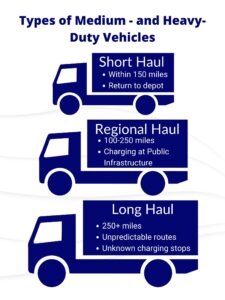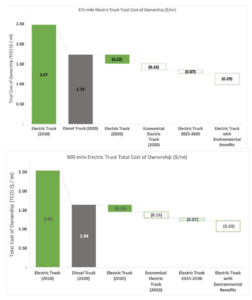Medium- and heavy-duty fleets are defined as a group of vehicles, each with a “gross vehicle weight rating over 8,500 pounds.” Examples of these vehicles include school and transit buses, fire trucks, delivery vehicles, and freight transportation. The heavy weight of these larger vehicles requires more energy to propel them forward, and thus medium- and heavy-duty vehicles contribute a disproportionate amount to air emissions. In total, medium- and heavy-duty fleets account for a third of global diesel demand, meaning the transition to alternative fuels and electric vehicle fleets would have a significant impact on diesel demand and air quality. Currently, medium- and heavy-duty vehicles make up only 5 percent of all vehicles on the road but are the second largest contributor to transportation emissions. A 2020 report by the EPA found that diesel powered medium- and heavy-duty fleets emitted 561 million metric tons of greenhouse gases. Electrifying trucks and other large vehicles offers an opportunity to reduce air pollution, save money, and use the latest technology.
Use cases for electric fleets

There are three types of medium- and heavy-duty fleets: short distance, regional haul, and long haul. The majority (67%) of freight travels a maximum of 250 miles, making it extremely realistic to transition to electric vehicles. Three of Clean Fuels Michigan members, Navistar, Rhombus, and Fontaine Modification work alongside fleets and contribute their technology to advance the electric vehicle sector. Navistar, a manufacturer and solution-provider for medium- and heavy-duty fleets, offers two short distance medium-duty electric vehicles, the International eMV Series medium-duty battery electric truck and the IC electric CE Series school bus. Jason Gies from Navistar explains, “school buses are considered an ideal case for EV applications. School buses return to their depot at the end of each route, have the opportunity for mid-day charge events between routes as well as at night, and the silent powertrain of an electric school bus provides for a quiet environment that helps the children riding the bus to stay calm and allows the bus driver to hear if a child is having a medical event.”
Fontaine Modification is a post-production truck modification servicer that helps fleets transition to electric. Dave Brosky says “at Fontaine Modification, we have integrated a number of different advanced EV systems into various Class 4-8 commercial vehicle platforms at several of our US locations. The EV systems we have integrated are Battery Electric (BEV), Hybrid Electric (HEV) and Fuel Cell Electric (FCEV). Our experience in working with integrating advanced systems on traditional gasoline and diesel powered commercial vehicles has positioned us well to expand into electrification.”
Lastly, Rhombus Energy Solutions provides a bidirectional DC fast charging solution for medium- and heavy- duty vehicles fleets that are designed for continuous operation, which means that “as each EV reaches its target charge level, the dispenser disconnects and connects to the next vehicle until all connected vehicles reach their target charge level.” It is typical to see medium- and heavy-duty vehicles parked end-to-end while they charge. Rhombus’ charging systems have a smaller footprint, allowing them to be easily placed next to the vehicles. Manoj Karwa, Vice President of Global Sales at Rhombus Energy Solutions, says that having vehicle to grid charging for these fleets is essential to driving costs down by selling excess vehicle power back to the grid.
Benefits of fleet electrification
 Fontaine Modifications various systems show that EVs can be effectively tailored to meet the needs and requirements of a wide range of commercial fleet applications. Navistar credits a few main reasons customers are interested in electric vehicles: the new technology, the desire to reduce greenhouse gas emissions, and to drive the total cost of ownership down through lower maintenance and refueling costs.A report from Berkeley Lab found that per mile, the total cost of ownership for electric fleets is 13% lower, which would save fleet operators $200,000 over 15 years. An electric vehicle does not require oil or transmission fluid changes which reduces maintenance costs and mitigates the time vehicles sit idle while being repaired. Fontaine Modification also notes that for some fleets, the lower overall total cost of ownership is due mainly to the lower energy & maintenance costs.
Fontaine Modifications various systems show that EVs can be effectively tailored to meet the needs and requirements of a wide range of commercial fleet applications. Navistar credits a few main reasons customers are interested in electric vehicles: the new technology, the desire to reduce greenhouse gas emissions, and to drive the total cost of ownership down through lower maintenance and refueling costs.A report from Berkeley Lab found that per mile, the total cost of ownership for electric fleets is 13% lower, which would save fleet operators $200,000 over 15 years. An electric vehicle does not require oil or transmission fluid changes which reduces maintenance costs and mitigates the time vehicles sit idle while being repaired. Fontaine Modification also notes that for some fleets, the lower overall total cost of ownership is due mainly to the lower energy & maintenance costs.
Rhombus also mentions that transitioning medium- and heavy- duty fleets to electric vehicles and using DC fast chargers allows for vehicle-to-grid money, back-up power, and provides clean, reliable transportation. Rhombus provides the example that in the case of a natural disaster, schools are currently used as shelters and with the transition to electric vehicles, bidirectional DC fast charging systems allow the vehicle to power the building, providing safety and electricity for the shelter.
Conclusion
Dave Brosky from Fontaine Modification says, “Fleets considering transitioning to any form of electric propulsion should take the time to understand and feel confident in the capabilities of the partners they intend to work with. A deep knowledge and understanding of the operating requirements of commercial vehicles and commercial fleets should be a primary consideration when evaluating electrification suppliers and integration partners.” There are many uses and benefits that your company could introduce to its medium- or heavy-duty fleets. Reach out to Fontaine (email), Navistar (email), or Rhombus (email) to learn more about electrifying your fleet.
